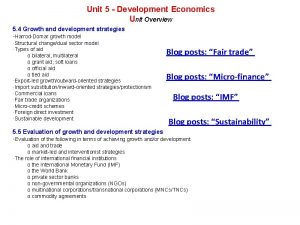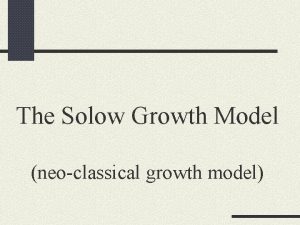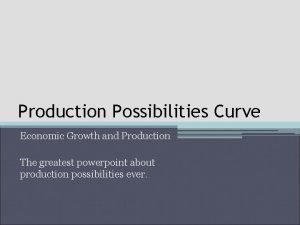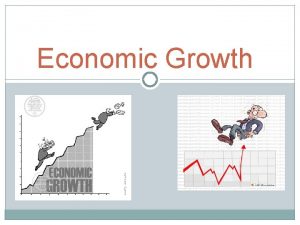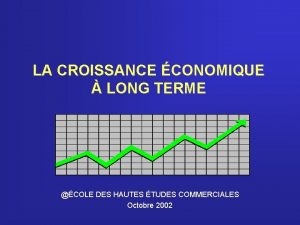THE FOUNDATIONS OF ECONOMIC GROWTH cole des Hautes

















- Slides: 17

THE FOUNDATIONS OF ECONOMIC GROWTH École des Hautes Études Commerciales (HÉC) October 2001

Beyond cycles, GDP is subject to an upward trend Trend GDP Actual GDP

What factors make such a sustained process of growth possible ? • It is useful to go back to the circular flow model. • The production and distribution of goods and services in the economy requires the supply of productive services by the households. • These productive services have two dimensions: – quantity: the number of person-hours available – quality: the output person-hour (e. g the productivity of the hours worked) • Real GDP is the product of these two dimensions.

AGGREGATE INCOME (monetary flow) PRODUCTIVE SERVICES (real flow) FIRMS HOUSEHOLDS GOODS AND SERVICES (real flow) AGGREGATE SPENDING (monetary flow)

GDP is a product • Let ’s define the variables: – L designates the number of employed workers and h designates the average duration of work (in hours). L · h thus represents the total number of hours worked in the economy over a given period of time. – y designates the average productivity of the hours worked (measured at constant prices). • Real GDP (which we will designate by the capital letter Y) is equal to the product of these three variables: Y = L·h·y

GDP is a product • In general, GDP increases: – when employment increases (L). – when the average duration of work increases (h). – when productivity increases (y). • Clearly however: – there is a limit to the average duration of work; therefore h cannot contribute to a sustained, unlimited expansion of GDP. – As a matter of fact, along with the general improvement in the standards of living, we have observed in most countries a simultaneous reduction in the average duration of the working week.

GDP per capita • Measuring the standards of living of a population is not simple because many dimensions are involved. • One important indicator of the standards of living of a population is its GDP per capita (Ypc) : Ypc = Y / N • Since Y is equal to L · h · y, we can write: Ypc = (L / N) ·h · y where (L/N) represents the percentage of the total population which is working.

GDP per capita • The percentage of the total population which is working depends upon three variables: – the share of the total population which is of working age. – the participation rate of the working age population (to participate means either being employed or being seeking a job (unemployed). The labor force is equal to the sum of the employed and the unemployed persons. – the unemployment rate (the number of persons seeking a job as a percentage of the labor force) • Nevertheless, none of these three variables can contribute to an unlimited growth in GDP per capita:

GDP per capita – the working age population (as a percentage of the total population) cannot increase indefinitely. – the participation rate cannot increase forever. – there is a lower limit to the rate of unemployment • We cannot escape the following conclusion: In the long-run, the only source of increase in the standards of living of a population is the increase in its average productivity.

The determinants of productivity growth The productivity function of the economy: y = f (K/Lh) • productivity depends on the stock of capital person-hour; • for a given state of technology, the productivity function is subject to the law of diminishing returns.

The productivity function y (K/Lh)

Implications of the law of diminishing In the absence of technological y x progress, the productivity gains x associated with a constant investment effort (in terms of rising Productivity gains at the advanced stages of investment x x K/Lh) are getting smaller and smaller. In the limit, these productivity gains tend to 0. Productivity gains at the earlier stages of investment Continual productivity gains are (K/Lh) thus impossible without technological progress.

In the long-run, the only source of increase in the standard of living of a population is technological progress y Technological progress allows for an upward shift in the productivity function (for instance, from T 1 to T 2). T 2 y 1 Technological progress is what permits a country to continue posting productivity gains and increase the standard of living of its population. T 1 y 0 (K/Lh) K/Lh However, technological progress is not exogenous. It depends on the quality of the human capital of a country and on its social and economic organization (including the structure of incentives).

Technological progress needs a parallel improvement in the abilities of the human resources y Technological progress, which is itself the product of the human capital, allows productivity to grow along the technology frontier T 2 instead of T 1. T 2 However, productivity will not grow along T 2 unless the human resources have been trained to use efficiently the new technology. T 1 K/Lh The shift from technology frontier T 1 to technology frontier T 2 is necessarily a gradual process. Without parallel investments in education and training, this process can never take off.

Summing up at this point. . . • GDP increases with increases in employment, increases in the average duration of work and increases in productivity. • GDP per capita depends on the importance of the working age population as a share of the total population, on the participation rate of the working age population, on the rate of unemployment of the labor force and on the average productivity of the employed population. • In the long-run however, GDP per capita depends only on the average productivity of the employed population. • For productivity gains to be continual there must be a continual improvement in technology. The latter is impossible without a continual improvement in the knowledge and skills (human capital) of the population. • In the long-run, the standards of living of a population depend entirely upon its capacity to innovate and absorb other populations’ innovations.

Some important extensions to discuss • Saving, investment and productivity growth • The role of foreign saving • The degree of substitution between foreign and domestic saving • Capital inflows and the external debt • Discussion in class on the convergence issue

THE FOUNDATIONS OF ECONOMIC GROWTH École des Hautes Études Commerciales (HÉC) October 2001
 Economic growth vs economic development
Economic growth vs economic development Growth and development conclusion
Growth and development conclusion Des des des
Des des des Economic foundations of strategy
Economic foundations of strategy What is plant growth analysis
What is plant growth analysis Monocots eudicots
Monocots eudicots Growthchain
Growthchain Primary growth and secondary growth in plants
Primary growth and secondary growth in plants Vascular ray
Vascular ray Geometric growth population
Geometric growth population Neoclassical growth theory vs. endogenous growth theory
Neoclassical growth theory vs. endogenous growth theory Organic growth vs inorganic growth
Organic growth vs inorganic growth Harrod domar model
Harrod domar model Solow's model of economic growth
Solow's model of economic growth Interest rates and economic growth
Interest rates and economic growth Ppc curve economic growth
Ppc curve economic growth Long run economic growth
Long run economic growth Long run economic growth graph
Long run economic growth graph












